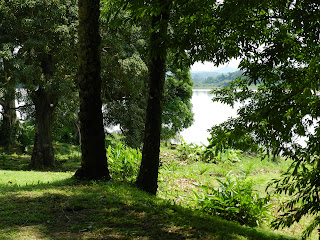My brief
moment of “zen” was quickly interrupted when our driver yelled for us to get
back in the truck. We started to head out of town taking RN1 (Route National
1). The road for the first hour was badly in need of repair and, although Ayesha
and I kept falling asleep, we would systematically wake up whenever there was a
particularly huge pothole.
When I was able to keep my eyes open, I saw many small
towns, with well built houses and many people. Almost every signle Gabonese
home, no matter how small or humble has neon strip lights out front. I
asked the driver if they were for killing mosquitos and he responded that they
were more energy efficient and cheaper. It was strange to see because you could
see all of these neon lights in the distance seemingly floating in the
mountainside.
Four hours later we arrived in Hopital Albert
Schweitzer in Lambarene. I was so drowsy I didn’t even look around. I just
blindly grapped for my suitcases, and lugged them behind our driver. He
unlocked a door and I saw our house for the first time. Here is some pictures of my house and some of the views from our windows!:
It was
surprisingly cozy and well equipped. The house has been used for students from
all over the world, the most recent inhabitants were two Swiss medical students. There are
four separate rooms each with its own locked door, a living room and kitchen
area (equipped with a gas stove). Some perks of our house are warm water, drinkable water (available throughout the complex), a flushing toilet, pretty consistent internet and an awesome
porch overlooking the Ogooue River. There are some downsides to our house: many many
holes in the screens, the most spiders I have ever seen and gigantic roaches.
We
immediately started cleaning, removing cobwebs, dodging spiders, using clorox
to clean everything in sight. The first night, we finished cleaning and,
because it was late, fell asleep under our mosquito nets. After three days of
travel we were exhausted.
I woke up to the sounds of our new home.
There is a chicken, (nickname: alarm clock), who is convinced that dawn is at
3:30 am. He is adamant that while the rest of the world sleeps, the inhabitants
of the student house MUST be awake at 3:30am.
In fact there are chickens everywhere, beautiful variegated chickens
that rest on every perch available. Here is a shot of our chickens that I took early one morning.
I was in for a surprise. When I looked out
of my window, I was in complete shock. I have concluded that Ayesha and I work
in paradise. The river is immense and beautiful. The mountains in the distance
are covered in dense forest and everywhere you look is green.
My favorite thing to do each morning before
work is to just stand at the window and look at the trees on the riverbank.
They are my constant photo subjects.
The hospital complex itself is a small
village. The hospital was built in 1913 by Dr. Albert Schweitzer, (who I will
dedicate an entire post to soon.) The original hospital is now a tourist
attraction, with a museum and daily tours of the old hospital. The modern
hospital has 152 beds, 6 physicians and 250 total staff, most of whom live on
the complex. There are five main services: pediatrics, adult medicine, surgery,
maternity and dentistry. The hospital sees approximately 30,000 outpatient
visits/year (>60% of all patients seen in the Moyen Ogooue region), 6,200
inpatients/year and 1,500 births/year. The complex is also home to a
world-renowned Medical Research Unite (with a focus on malaria) and a thriving
public health program for mothers (Protection Maternelle et Infantile).
Aerial Photos Courtesy of Albert Schweitzer Foundation
There are two restaurants, a seamstress, a
laundry, a small food store and even a small outdoor market during the week
under a large tree. Most of the people who work in the hospital also live on
the hospital grounds. It is not unusual to see the same nurse who helped me
move a patient in the morning, at her house in the afternoon cleaning fish for
dinner. There are schools for the elementary and middle school students and in
the afternoons, their excited post-school chatter drifts through my window. The
older kids host heated soccer games on the soccer field in the middle of the
complex .
The physicians all live in the complex,
including the surgeons, pediatrician, internists and dentist. In fact, the
dentist’s clinic is across from our house and he, his wife (a nurse in
pediatrics) and their two small children live in an apartment directly below
the clinic.
In my next posts, I hope to focus on my
life as a stagiare in the hospital’s
adult medicine service (Ayesha works in pediatrics). The cases are fascinating,
and I have tried to capture the pertinent information about what I have seen so
far. For clarity, I have decided to focus on a different aspect of the medicine
service for each group of posts, rather than trying to relay everything
chronologically. First up is sexually transmitted diseases and the HIV epidemic
here.








No comments:
Post a Comment